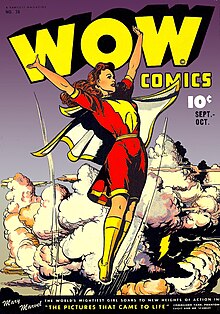Superhero comics
This article includes a list of references, related reading, or external links, but its sources remain unclear because it lacks inline citations. (May 2010) |
| Superhero comics | |
|---|---|
 Cover of Wow Comics 38 (September/October 1941) | |
| Authors | |
| Publishers | |
| Publications | |
| Series | |
| Related genres | |
Superhero comics are one of the most common genres of American comic books. The genre rose to prominence in the 1930s and 1940s and has remained the dominant form of comic book in North America since the 1960s. Superhero comics feature stories about superheroes and the universes these characters inhabit.
Beginning with the introduction of Superman in 1938 in Action Comics #1 — an anthology of adventure features — comic books devoted to superheroes (heroic people with extraordinary or superhuman abilities and skills, or god-like powers and attributes) ballooned into a widespread genre, coincident with the beginnings of World War II and the end of the Great Depression.
Precursors
In comics format, superpowered and costumed heroes like Popeye and The Phantom had appeared in newspaper comic strips for several years prior to Superman. The masked detective The Clock first appeared in the comic book Funny Pages #6 (Nov. 1936).
The Golden Age (c. 1938 – c. 1950)
In the Great Depression and World War II era the first Superhero Comics appeared, the most popular being Superman, Batman, Captain Marvel, Wonder Woman and Captain America.
Decline
After World War II superhero comic books gradually declined in popularity, their sales hindered in part by the publication of Seduction of the Innocent and the investigations of The Senate Subcommittee hearings on juvenile delinquency.
The Silver Age (c.1956 – c. 1970)
Beginning in the 1950s, DC began publishing revised versions of their 1940s superhero characters such as The Flash and Green Lantern with more of a science fiction focus. Marvel Comics followed suit in the 1960s, introducing characters such as Spider-Man, the Fantastic Four, the Hulk, Thor, the X-Men and Iron Man who featured more complex personalities which had more dramatic potential.
The Bronze Age (c. 1970 – c. 1985)
Superhero Comics became much more political and dealt with social issues such as the short-lived run of Green Lantern/Green Arrow by Denny O'Neil and Neal Adams and the Captain America story arc of the superhero's political disillusionment by Steve Englehart. This was eventually supplanted by more sophisticated character driven titles of The Uncanny X-Men by Chris Claremont and John Byrne for Marvel and The New Teen Titans by Marv Wolfman and George Pérez for DC. Anti-Hero becomes popular with appearances of the Punisher, Wolverine, Ghost Rider and a 1980s revival of Daredevil by Frank Miller.
The Modern Age (c. 1985–present)
Superhero Comics became darker with the release of landmark deconstructive works such as Watchmen and The Dark Knight Returns, which led to many imitations. In the 1990s, Image Comics released successful new characters including the Anti-Hero Spawn which were predominantly creator owned as opposed to Marvel and DC's which were corporate owned. The Comic Book Mini Series Kingdom Come brought an end to the popularity of the Anti-Hero and encouraged instead a reconstruction of the genre with superhero characters that endeavored to combine artistic and literary sophistication with idealism
See also
References
- Benton, Mike (1991). Superhero Comics of the Silver Age: The Illustrated History. Taylor History of Comics. Taylor Publishing. p. 226. ISBN 0-87833-746-6.
- Benton, Mike (1992). Superhero Comics of the Golden Age: The Illustrated History. Taylor History of Comics. Taylor Publishing. p. 202. ISBN 0-87833-808-X.
- Garrett, Greg (2007). Holy Superheroes!: Exploring the Sacred in Comics, Graphic Novels, and Film. Westminster John Knox Press. p. 216. ISBN 0-664-23191-8.
- Howe, Sean 2012). Marvel Comics: the Untold Story. First ed. New York: Harper. 485 p. ISBN 978-0-06-199210-0
- Jacobs, Will and Gerard Jones (1985). The Comic Book Superheroes, from the Silver Age to the Present. New York: Crown Publishers. xi, 292 p. ISBN 0-517-55440-2
- Klock, Geoff (2002). How to Read Superhero Comics and Why. Continuum International Publishing Group. p. 204. ISBN 0-8264-1418-4.
- Knowles, Christopher (2007). Our Gods Wear Spandex: The Secret History of Comic Book Heroes. Illustrated by Joseph Michael Linsner. Weiser. p. 256. ISBN 1-57863-406-7.
- LoCicero, Don (2007). Superheroes and Gods: A Comparative Study from Babylonia to Batman. McFarland & Company. p. 249. ISBN 0-7864-3184-9.
